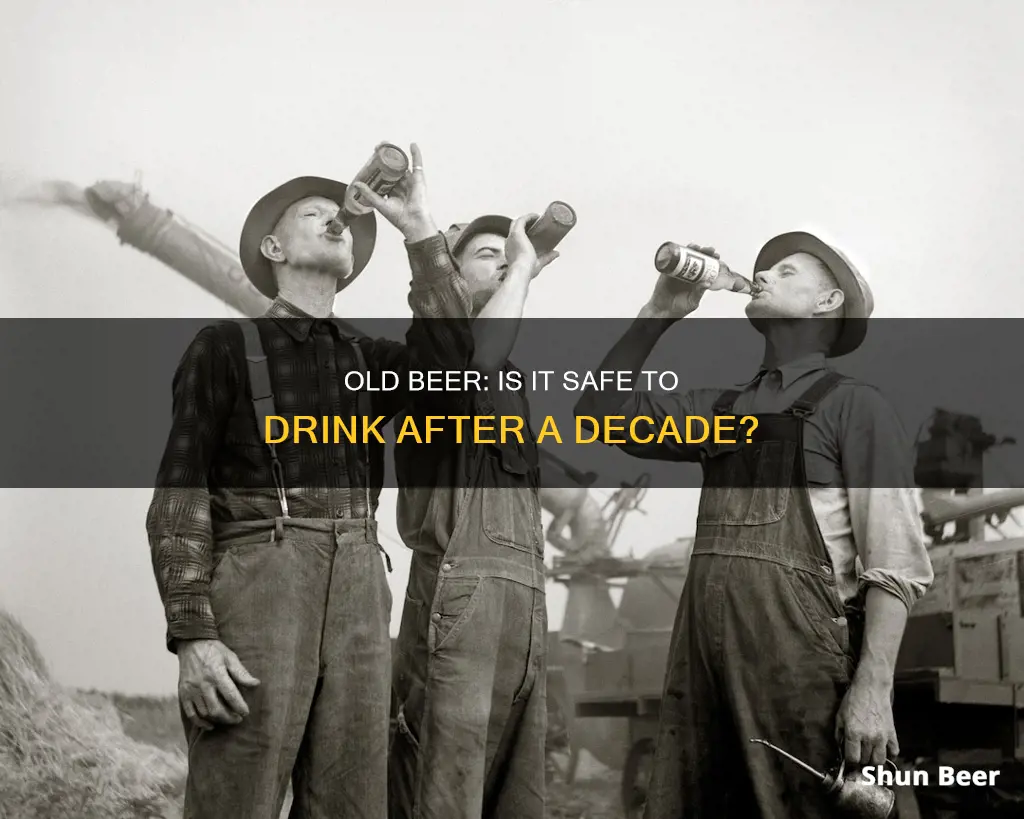
Beer is produced with expiry dates, but it is safe to drink beer past its best before date. While it may not taste very good, drinking old beer will not make you sick. Beer is resistant to spoiling because it is either pasteurized or filtered, which eliminates bacteria. The flavour of beer is, however, killed more easily by oxidation than anything else.
| Characteristics | Values |
|---|---|
| Is 10-year-old beer safe to drink? | Yes, it is safe to drink. No harmful pathogens will grow in the beer. |
| Will it taste good? | Probably not. Beer does not age gracefully. It will likely be oxidized, smell odd, and taste stale or flat. |
| How long does beer last? | Beer kept in the pantry will taste good for 6-9 months. Refrigerated beer can last up to 2 years. |
| What about stronger beers? | Stronger beers, like porters or imperial stouts, can stay tasting good for between 5 and 10 years after brewing. |
| How to store beer? | Store beer upright at a temperature of approximately 60 degrees Fahrenheit. Refrigerate if possible. |
What You'll Learn

Is 10-year-old beer safe to drink?
Beer typically has a 'best before' date, which is a guideline on quality rather than safety. Drinking beer past its 'best before' date is usually safe, but it might not taste very nice. The flavour of beer is killed more easily by oxidation than anything else, so it may taste stale or flat.
However, if a beer has a 'use by' date, it should be consumed before this date, as degradation happens quickly and bacterial build-up may cause the drinker to become ill.
The shelf life of beer depends on the type of beer and how it is stored. Standard strength beers, such as pale ales, IPAs and lagers, stay fresh for between 6 months and 2 years after brewing when stored at room temperature. Storing beer in the fridge increases this timeframe to up to 2 years. Stronger beers, like porters or imperial stouts, can taste good for between 5 and 10 years after brewing.
Some beers, like IPAs, gradually lose their flavour and aroma over time and are best drunk sooner rather than later. However, richer and higher ABV varieties, such as porters and stouts, can improve with age, especially if they are stored in cool, dark conditions.
Overall, drinking 10-year-old beer is likely to be safe, but it may not taste very pleasant.
How to Drink Beer: The Head Conundrum
You may want to see also

What does 10-year-old beer taste like?
While drinking a 10-year-old beer may be safe, it is unlikely to taste very good. Beer is not designed to age gracefully, and the longer it sits, the more oxidized it becomes. Oxidation occurs when oxygen breaks down chemicals, which is why old beer may taste like cardboard or soy sauce.
Standard-strength beers, such as pale ales, IPAs, and lagers, are only likely to stay fresh for between 6 months and 2 years after brewing. Therefore, a 10-year-old beer of this variety is likely to be stale. Stronger beers, like porters or imperial stouts, on the other hand, can stay tasting good for between 5 and 10 years after brewing.
Proper storage is essential to preserving the taste of beer. Beer should be stored upright at a temperature of approximately 60 degrees Fahrenheit. Even with proper storage, however, beer will lose its flavour more easily to oxidation than anything else.
While drinking a 10-year-old beer may be safe for your health, it is not recommended for your taste buds.
Beer and Flu Medication: A Safe Mix?
You may want to see also

How long does unopened beer last in the fridge?
Beer is produced with expiry dates, but these are more of a guideline on quality than safety. Beer won't go bad in the same way that food does, and it's safe to drink even if it's past its "best before" date. However, the taste will deteriorate over time, and it's unlikely you'll enjoy drinking old beer.
Properly stored unopened beer will generally stay at its best quality for about 6 to 8 months in the refrigerator, although it will remain safe to drink after that period. If kept at room temperature, beer will last for 6 to 9 months beyond the "best before" date. Stronger beers, like porters or imperial stouts, can stay tasting good for between 5 and 10 years after brewing.
If you're storing beer in the fridge, it's important to keep it upright and to maintain a consistent temperature. Changes in temperature can negatively affect the flavour. If the beer is in bottles, fluctuations in temperature can affect the amount of carbon dioxide in the liquid, which could cause the bottle to crack or even explode.
You can tell if a beer has gone bad by its smell and taste. If it has a bad aroma, or if it's missing the usual carbonation and foaming when you open it, it's probably gone bad. You might also see excessive sediment at the bottom of the bottle, which can contribute to a poor taste.
A Day at the Beer Hall: A Beginner's Guide
You may want to see also

Can old beer cause health issues?
It is important to note that old beer does not cause any serious health issues. However, it is not the best idea to drink it. Here's why:
Firstly, old beer is completely safe to drink and will not make you sick. Beer has antimicrobial characteristics due to its alcohol content and hops, which prevent pathogenic bacterial growth. This means that harmful pathogens will not grow in the beer, even if it is old. So, if you accidentally drink a beer that is past its "best by" date, you don't have to worry about any health risks.
Secondly, the main issue with old beer is the taste. Beer does not age gracefully and is not designed to be aged like wine. As beer gets older, it undergoes oxidation, which occurs when oxygen breaks down its chemicals. This process gives old beer a stale, flat, or vinegary taste, sometimes described as tasting like cardboard or soy sauce. While this won't harm your health, it won't provide a pleasant drinking experience.
Additionally, the appearance and smell of old beer can also be unappealing. It may develop a "dusty" settlement at the bottom of the bottle, and its smell may change, becoming strange or skunky due to exposure to UV light.
Moreover, the effects of drinking old beer may vary depending on the type of beer and how it was stored. Stronger beers, such as porters or imperial stouts, can retain their taste for up to 5 to 10 years if stored properly. On the other hand, lighter beers like lagers or IPAs are best consumed within a year or two of brewing. Storing beer upright in a cool, dark place, preferably a refrigerator, can help prolong its shelf life.
In conclusion, while old beer won't cause serious health issues, it is not recommended for consumption due to its unpleasant taste and sensory qualities. It is always better to enjoy your beer fresh and as close to its "born on" date as possible.
Beer and Afib: What You Need to Know
You may want to see also

How to store beer to extend its life?
Beer is an organic substance, meaning it contains chemical compounds from living things, such as yeast. Improper storage can cause the beer to spoil. Here are some tips to store beer and extend its life:
Avoid Sunlight Exposure
Beer stored in dark bottles helps protect the liquid from the sun's UV rays, which create a chemical reaction in the beer, breaking down its flavour components until the beverage smells and tastes like skunk spray. Beer that has been exposed to sunlight for too long is said to be "skunked" or "lightstruck". Brown bottles are best for minimising the effects of light strike, while green bottles can only block ultraviolet light, and clear bottles have no protection.
Avoid Exposure to Oxygen
Overexposure to oxygen leads to a breakdown of the beer's chemicals, which can significantly alter the taste. Bottled beer is at a higher risk of oxygen exposure than canned beer, and storing beer upright minimises contact with the air. Keeping bottled beer on its side makes it prone to air leaks.
Avoid High Temperatures
Heat will accelerate the chemical reaction, making the natural breakdown of large molecules into small molecules occur more rapidly. This means that in hotter conditions, beer will age faster. Fluctuations in temperature are not ideal for beer, but they are not harmful. A good rule of thumb is to never leave your beer anywhere that you would not leave your dog.
Store Beer Upright
Storing beer upright limits the amount of beer exposed to oxygen, thus slowing the rate of oxidation. It also ensures that yeast compact at the bottom of the bottle, minimising the influence on flavour.
Store Beer in a Cool Place
A cool, dark place is the universal ideal for storing beer, with the definition of "cool" being between room temperature and freezing. Refrigeration is always a better option than leaving beer at room temperature, as the cold will help slow down the aging process and protect the beer from UV rays and heat.
Store Beer According to Type
The variety or style of beer also plays a role in its shelf life. Lighter beers, such as pale ales, wheat beers and lagers, are usually lower in alcohol, so they should be consumed within three months of packaging. Heavier beers like stouts and porters have a longer shelf life of about six months. Barrel-aged beers, including sour ales and imperial beers, tend to have higher alcohol content and need time to reach their peak flavour.
Beer Belly Blues: Why Beer Upsets Your Stomach
You may want to see also
Frequently asked questions
Drinking 10-year-old beer is safe, but it's unlikely to taste good. Beer doesn't age like wine, and even beers with higher alcohol content will eventually go stale.
Beer typically lasts 6-24 months after its best-before date if kept in the fridge, and up to 9 months if stored at room temperature. Stronger beers, like porters or imperial stouts, can taste good for 5-10 years after brewing.
You'll know a beer has gone bad from its smell and taste. It may also lack the usual 'pssst' sound and foaming when you open it, and there may be excessive sediment at the bottom of the bottle.







